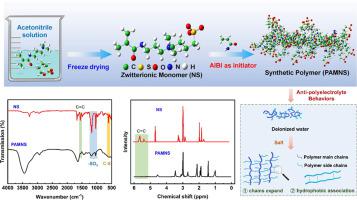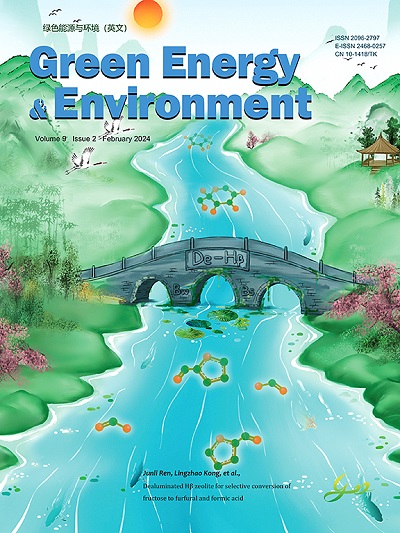A Salt-induced Tackifying Polymer for Enhancing Oil Recovery in High Salinity Reservoirs: Synthesis, Evaluation, and Mechanism
IF 10.7
1区 工程技术
Q1 CHEMISTRY, PHYSICAL
引用次数: 0
Abstract
Polymer flooding is an effective method widely applied for enhancing oil recovery (EOR) by reducing the mobility ratio between the injected water and crude oil. However, traditional polymers encounter challenges in high salinity reservoirs due to their salt sensitivity. To overcome this challenge, we synthesized a zwitterion polymer (PAMNS) with salt-induced tackifying property through copolymerization of acrylamide and a zwitterion monomer, methylacrylamide propyl-N, N-dimethylbutylsulfonate (NS). NS monomer is obtained from the reaction between 1,4-butanesultone and dimethylamino propyl methylacrylamide. In this study, the rheological properties, salt responsiveness, and EOR efficiency of PAMNS were evaluated. Results demonstrate that PAMNS exhibits desirable salt-induced tackifying characteristics, with viscosity increasing up to 2.4 times as the NaCl concentration reaches a salinity of 30 ×104mg L-1. Furthermore, high valence ions possess a much stronger effect on enhancing viscosity, manifested as Mg2+ > Ca2+ > Na+. Molecular dynamics simulations (MD) and fluid dynamics experiment results demonstrate that PAMNS molecules exhibit a more stretched state and enhanced intermolecular associations in high-salinity environments. It is because of the salt-induced tackifying, PAMNS demonstrates superior performance in polymer flooding experiments under salinity ranges from 5 ×104mg L-1 to 20 ×104mg L-1, leading to 10.38-19.83% higher EOR than traditional polymers.

高矿化度油藏盐致增粘聚合物的合成、评价及机理
聚合物驱是一种通过降低注入水与原油的流度比来提高采收率的有效方法。然而,由于传统聚合物的盐敏感性,在高矿化度油藏中遇到了挑战。为了克服这一挑战,我们通过丙烯酰胺和两性离子单体甲基丙烯酰胺丙基- n, n -二甲基丁基磺酸盐(NS)的共聚,合成了一种具有盐诱导增粘性能的两性离子聚合物(PAMNS)。由1,4-丁烷磺酸与二甲氨基丙基甲基丙烯酰胺反应得到NS单体。在这项研究中,评估了PAMNS的流变性能、盐响应性和EOR效率。结果表明,PAMNS表现出良好的盐致增粘特性,当NaCl浓度达到30 ×104mg L-1时,其粘度增加了2.4倍。此外,高价离子对黏度的增强作用更强,表现为Mg2+ > Ca2+ > Na+。分子动力学模拟(MD)和流体动力学实验结果表明,在高盐度环境中,PAMNS分子表现出更强的拉伸状态,并增强了分子间的联系。由于盐致增粘作用,PAMNS在5 ×104mg L-1 ~ 20 ×104mg L-1矿化度范围内的聚合物驱实验中表现出优异的性能,提高了10.38 ~ 19.83%的原油采收率。
本文章由计算机程序翻译,如有差异,请以英文原文为准。
求助全文
约1分钟内获得全文
求助全文
来源期刊

Green Energy & Environment
Energy-Renewable Energy, Sustainability and the Environment
CiteScore
16.80
自引率
3.80%
发文量
332
审稿时长
12 days
期刊介绍:
Green Energy & Environment (GEE) is an internationally recognized journal that undergoes a rigorous peer-review process. It focuses on interdisciplinary research related to green energy and the environment, covering a wide range of topics including biofuel and bioenergy, energy storage and networks, catalysis for sustainable processes, and materials for energy and the environment. GEE has a broad scope and encourages the submission of original and innovative research in both fundamental and engineering fields. Additionally, GEE serves as a platform for discussions, summaries, reviews, and previews of the impact of green energy on the eco-environment.
 求助内容:
求助内容: 应助结果提醒方式:
应助结果提醒方式:


